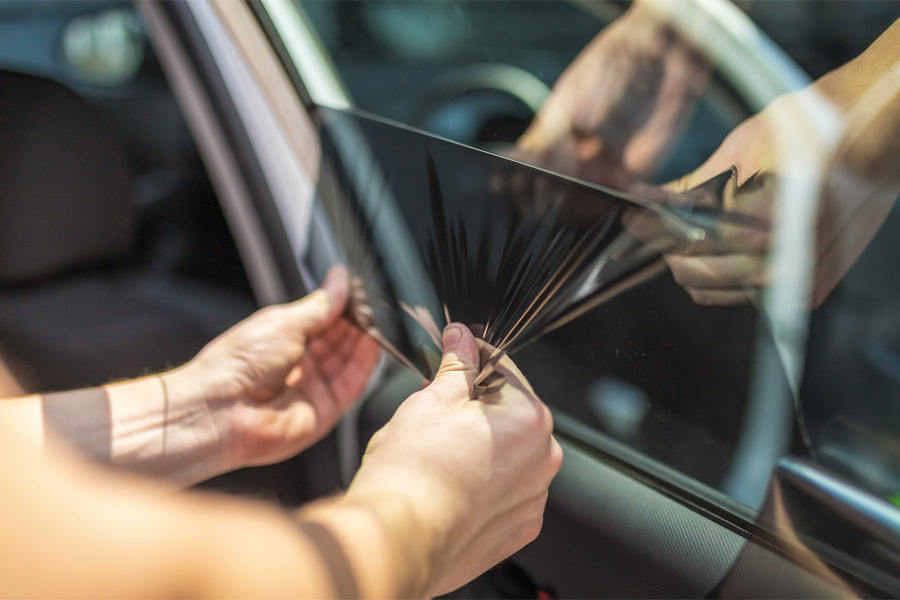How Auto Window Tinting Keeps Your Lorry Cool in Heat
How Auto Window Tinting Keeps Your Lorry Cool in Heat
Blog Article
Home Window Tinting Rules and Guidelines: What You Need to Know Prior To Tinting Your Cars And Truck
Before continuing with window tinting for your vehicle, it is vital to acquaint yourself with the diverse regulations and guidelines that govern this technique across various states. These laws determine the allowable degrees of color darkness, commonly measured by noticeable light transmission (VLT) percents, and include details terms for front windscreens aimed at making certain roadway safety and security.
Review of Home Window Tinting Laws
Window tinting laws are frequently based on variation across different jurisdictions, showing neighborhood laws and safety and security factors to consider. These laws dictate the allowable levels of tint darkness and reflectiveness on lorry home windows, guaranteeing that vehicle drivers maintain appropriate exposure while also safeguarding against dangerous UV rays and warm.
The majority of policies classify window tinting based upon the Visible Light Transmission (VLT) portion, which suggests the amount of light that can go through the home window. Typically, reduced VLT percents signify darker colors. Legislations usually set apart between the front, side, and back home windows, with stricter restrictions used to the front windscreen to enhance safety and security for both the driver and various other road users.
In addition, some territories enforce constraints on the reflectivity of the color, avoiding excessive glare that can hinder exposure. Exemptions to these laws might exist for individuals with specific clinical conditions requiring extra sun security. Compliance with home window tinting regulations is vital, as infractions can cause penalties, mandatory elimination of the tint, and potential rises in insurance coverage costs. It is vital for car owners to familiarize themselves with local laws prior to proceeding with home window tinting installments.
State-by-State Color Regulations
Recognizing the certain home window tinting laws in each state is crucial for automobile owners looking for to follow the regulation. Each state in the united state has actually established its own set of rules governing home window tinting, which can vary significantly. These policies typically dictate the permitted levels of color darkness, the kinds of windows that can be tinted, and any type of clinical exemptions that may use.
For example, states like The golden state have rigorous limitations on color darkness for front windows, while others, such as New Mexico, may allow darker tints. Furthermore, particular states mandate certain visibility portions for various windows, consisting of the windscreen, front side windows, and rear home windows. It is critical for auto proprietors to acquaint themselves with their state's legislations to avoid prospective penalties or fines.
Furthermore, some states may call for an accreditation sticker to be put on tinted home windows, suggesting compliance with state regulations. Failing to abide by these guidelines not just runs the risk of legal effects but can likewise influence safety and exposure while driving. As a result, car proprietors need to perform extensive research study or speak with neighborhood authorities to make certain full understanding and conformity with state-by-state tint regulations.
Allowed Color Types and degrees
Several vehicle owners might be stunned to discover that enabled color levels and types vary widely across various states. Each state has actually established its very own regulations concerning the acceptable darkness and reflectivity of home window tint, frequently determined by Visible Light Transmission (VLT) portions. VLT describes the quantity of light that can travel through the tinted home windows; thus, a lower portion indicates a darker tint.

Moreover, the kinds of tint products permitted can differ, with some states prohibiting mirror-like or metallic finishes. It is crucial for vehicle owners to acquaint themselves with their state's particular regulations to make certain compliance. Non-compliance can result in fines, mandatory removal of the color, or various other lawful effects, making it vital to recognize these laws before continuing with installment.
Medical Exemptions for Tinting
While not all states give allowances for clinical exceptions concerning window tinting, those that do acknowledge the requirement for details people to improve presence and comfort due to clinical problems. Various medical conditions, such as lupus, skin cancer, and specific eye conditions, can render people particularly conscious sunlight. These her response individuals might require darker colors to protect themselves from hazardous UV rays and glow.

It is essential to note that despite having a clinical exemption, there might still be constraints on the level of color enabled. Compliance with state legislations makes certain that individuals are both secured and within lawful limits. Those thinking about clinical exemptions should contact their local Division of Electric motor Automobiles or equal authority to comprehend the treatments and requirements required to apply for an exception effectively.
Charges for Non-Compliance
Stopping working to follow home window tinting legislations can cause considerable charges, which vary by state. Legislation enforcement firms are encouraged to release citations for cars that do not abide by the specified these details tinting guidelines. These charges normally include fines, which can range from small total up to numerous hundred bucks, relying on the seriousness of the violation and the state in question.
In some territories, repeated offenses may lead to escalating penalties or extra charges, such as necessary court looks. Moreover, non-compliance might necessitate the removal of illegal tinting, commonly at the proprietor's expenditure. In extreme cases, habitual culprits might face suspension of their vehicle registration till conformity is achieved.
In addition, insurance policy effects may arise from obtaining numerous citations for home window color violations. Insurers might view such violations as an indication of riskier actions, possibly causing increased costs or difficulty in protection.
To avoid these fines, it is critical for car owners to familiarize themselves with their neighborhood home window tinting legislations and ensure that their automobile complies (Window hop over to here Tinting). This proactive method not just stays clear of lawful ramifications yet likewise advertises roadway security
Conclusion

A lot of laws categorize window tinting based on the Visible Light Transmission (VLT) percentage, which suggests the quantity of light that can pass via the home window. Conformity with home window tinting regulations is essential, as infractions can result in penalties, required removal of the color, and possible boosts in insurance coverage costs.Recognizing the specific home window tinting regulations in each state is important for lorry owners looking for to conform with the regulation. These regulations usually dictate the allowable levels of tint darkness, the types of windows that can be tinted, and any kind of medical exemptions that may apply.
For circumstances, states like California have strict restrictions on tint darkness for front home windows, while others, such as New Mexico, may permit darker colors.
Report this page